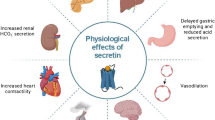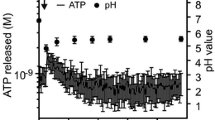Abstract
Cellular mechanisms underlying the impairment of pancreatic fluid and electrolyte secretion in diabetes were examined using interlobular ducts isolated from rat pancreas. Fluid secretion was assessed by monitoring changes in luminal volume. HCO −3 uptake across the basolateral membrane was estimated from the recovery of intracellular pH following an acid load. Exposure to high glucose concentrations inhibited fluid secretion and reduced the rate of basolateral HCO −3 uptake in secretin-stimulated ducts isolated from normal rats. In ducts isolated from streptozotocin-treated diabetic rats, fluid secretion and basolateral HCO −3 uptake were also severely impaired but could be largely reversed by incubation in normal-glucose solutions. Sodium-dependent glucose cotransporter 1 (SGLT1), glucose transporter (GLUT)1, GLUT2, and GLUT8 transcripts were detected by reverse transcriptase polymerase chain reaction in isolated ducts. Raising the luminal glucose concentration in microperfused ducts caused a depolarization of the membrane potential, consistent with the presence of SGLT1 at the apical membrane. Unstimulated ducts filled with high-glucose solutions lost luminal fluid by a phlorizin-sensitive mechanism, indicating that pancreatic ducts are capable of active glucose reabsorption from the lumen via SGLT1. In ducts exposed to high glucose concentrations, continuous glucose diffusion to the lumen and active reabsorption via SGLT1 would lead to elevation of intracellular Na+ concentration and sustained depolarization of the apical membrane. These two factors would tend to inhibit the basolateral uptake and apical efflux of Cl− and HCO −3 and could therefore account for the impaired fluid and electrolyte secretion that is observed in diabetes.








Similar content being viewed by others
References
Argent BE, Gray MA, Steward MC, Case RM (2006) Cell physiology of pancreatic ducts. In: Johnson LR, Barrett KE, Ghishan FK, Merchant JL, Said HM, Wood JD (eds) Physiology of the gastrointestinal tract, 4th edn. Elsevier Academic Press, New York, pp 1371–1396
Balen D, Ljubojevic M, Breljak D, Brzica H, Zlender V, Koepsell H, Sabolic I (2008) Revised immunolocalization of the Na+-D-glucose cotransporter SGLT1 in rat organs with an improved antibody. Am J Physiol Cell Physiol 295:C475–C489
Benjamin K, Matzner MJ, Sobel AE (1936) A study of external pancreatic secretion in man. J Clin Invest 15:393–396
Busik JV, Hootman SR, Greenidge CA, Henry DN (1997) Glucose-specific regulation of aldose reductase in capan-1 human pancreatic duct cells In vitro. J Clin Invest 100:1685–1692
Chey WY, Shay H, Shuman CR (1963) External pancreatic secretion in diabetes mellitus. Ann Intern Med 59:812–821
Creutzfeldt W, Gleichmann D, Otto J, Stöckmann F, Maisonneuve P, Lankisch PG (2005) Exocrine pancreatic function in insulin-dependent diabetes mellitus. Digestion 72:71–75
Fernández-Salazar MP, Pascua P, Calvo JJ, López MA, Case RM, Steward MC, San Román JI (2004) Basolateral anion transport mechanisms underlying fluid secretion by mouse, rat and guinea-pig pancreatic ducts. J Physiol 556:415–428
Frier BM, Saunders JH, Wormsley KG, Bouchier IA (1976) Exocrine pancreatic function in juvenile-onset diabetes mellitus. Gut 17:685–691
Hootman SR, Jones JE, Kapoor R, Nguyen KL, de Ondarza J (1998) Sodium, potassium-activated adenosine triphosphatase activity is impaired in the guinea pig pancreatic duct system in streptozotocin-induced diabetes. Biochem Biophys Res Commun 243:869–873
Ishiguro H, Naruse S, Steward MC, Kitagawa M, Ko SB, Hayakawa T, Case RM (1998) Fluid secretion in interlobular ducts isolated from guinea-pig pancreas. J Physiol 511:407–422
Ishiguro H, Steward MC, Lindsay AR, Case RM (1996) Accumulation of intracellular HCO -3 by Na+-HCO -3 cotransport in interlobular ducts from guinea-pig pancreas. J Physiol 495:169–178
Ishiguro H, Steward MC, Naruse S, Ko SB, Goto H, Case RM, Kondo T, Yamamoto A (2009) CFTR functions as a bicarbonate channel in pancreatic duct cells. J Gen Physiol 133:315–326
Kellett GL (2001) The facilitated component of intestinal glucose absorption. J Physiol 531:585–595
Kim KH, Lee HS, Kim CD, Chun HJ, Song CW, Um SH, Ryu HS, Hyun JH (2000) Evaluation of pancreatic exocrine function using pure pancreatic juice in noninsulin-dependent diabetes mellitus. J Clin Gastroenterol 31:51–54
Lam WF, Masclee AA, Souverijn JH, Lamers CB (1999) Effect of acute hyperglycemia on basal, secretin and secretin + cholecystokinin stimulated exocrine pancreatic secretion in humans. Life Sci 64:617–626
Lankisch PG, Manthey G, Otto J, Koop H, Talaulicar M, Willms B, Creutzfeldt W (1982) Exocrine pancreatic function in insulin-dependent diabetes mellitus. Digestion 25:211–216
Masyuk AI, Masyuk TV, Tietz PS, Splinter PL, LaRusso NF (2002) Intrahepatic bile ducts transport water in response to absorbed glucose. Am J Physiol Cell Physiol 283:C785–C791
Mizuno N, Naruse S, Kitagawa M, Ishiguro H, Hayakawa T (2000) Effects of phospholipase A2 inhibitors on Ca2+ oscillations in pancreatic acinar cells. Pancreas 20:77–83
Novak I, Greger R (1988) Properties of the luminal membrane of isolated perfused rat pancreatic ducts. Effect of cyclic AMP and blockers of chloride transport. Pflugers Arch 411:546–553
Okabayashi Y, Otsuki M, Ohki A, Nakamura T, Tani S, Baba S (1988) Secretin-induced exocrine secretion in perfused pancreas isolated from diabetic rats. Diabetes 37:1173–1180
Steward MC, Ishiguro H, Case RM (2005) Mechanisms of bicarbonate secretion in the pancreatic duct. Annu Rev Physiol 67:377–409
Williams JA, Goldfine ID (1993) The insulin-acinar relationship. In: Go VLW, Dimagno EP, Gardner JD, Lebenthal E, Reber HA, Scheele GA (eds) The pancreas: biology, pathophysiology, and disease, 2nd edn. Raven Press, New York, pp 789–802
Wright EM, Loo DDF, Hirayama BA, Turk E (2006) Sugar absorption. In: Johnson LR, Barrett KE, Ghishan FK, Merchant JL, Said HM, Wood JD (eds) Physiology of the gastrointestinal tract, 4th edn. Elsevier Academic Press, New York, pp 1653–1666
Yamamoto A, Ishiguro H, Ko SBH, Suzuki A, Wang Y, Hamada H, Mizuno N, Kitagawa M, Hayakawa T, Naruse S (2003) Ethanol induces fluid hypersecretion in guinea-pig pancreatic duct cells. J Physiol 551:917–926
Acknowledgements
This work was supported by grants from the Japanese Society for the Promotion of Science and the Ministry of Health, Labor, and Welfare, Japan. We thank Dr. A. K. Stewart for helpful discussions.
Author information
Authors and Affiliations
Corresponding author
Rights and permissions
About this article
Cite this article
Futakuchi, S., Ishiguro, H., Naruse, S. et al. High glucose inhibits HCO −3 and fluid secretion in rat pancreatic ducts. Pflugers Arch - Eur J Physiol 459, 215–226 (2009). https://doi.org/10.1007/s00424-009-0731-6
Received:
Revised:
Accepted:
Published:
Issue Date:
DOI: https://doi.org/10.1007/s00424-009-0731-6




